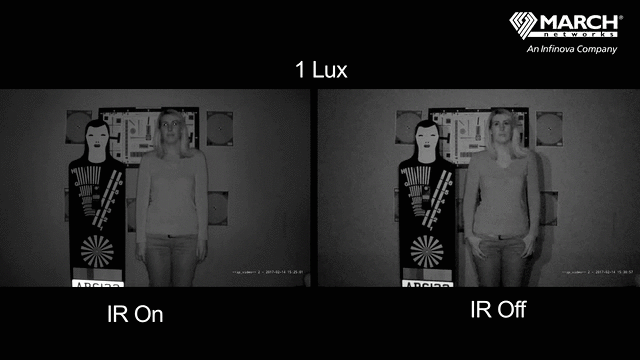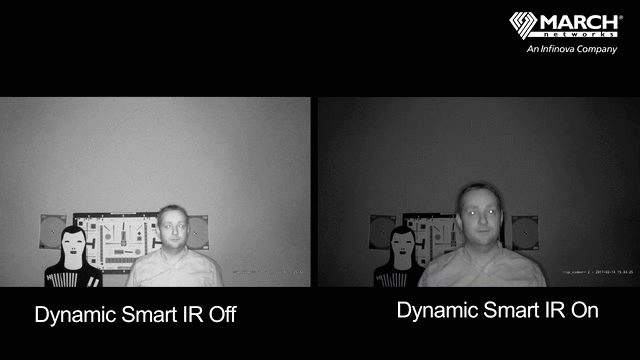How To Night Vision Camera
Security is typically an around-the-clock job that doesn't end only because the sunday goes downwardly. Many of our customers, especially within the commercial industrial sector, require advanced tools for nighttime surveillance to provide perimeter security or to monitor buildings or other assets after dark. I always recommend IP cameras with built-in IR (Infrared) LEDs for the highest quality nighttime video surveillance footage.
Seeing what the human eye tin can't
IR or night vision cameras use infrared calorie-free to illuminate images in the dark.
Nosotros can't see it, but infrared light is really all around us. IR cameras detect these invisible infrared wavelengths, enabling the camera to see in the dark. Most IR cameras have a series of IR LEDs (ofttimes situated effectually the lens) that transmit infrared light at night, or whenever the camera switches to night mode.
Since infrared light can interfere with color images, most IR cameras take an IR cut-off filter to cake infrared light during the daytime. The filter sits between the camera'due south lens and sensor, to let visible light to pass through in the daytime, while blocking out infrared wavelengths. Once the light level drops to a certain point, the filter shifts to allow infrared calorie-free in. This process is sometimes called True Mean solar day Night (TDN) because it delivers truthful color images during the day, and black and white or night vision images at dark.
In situations where there is minimal to no ambient light (for case, nighttime surveillance of retail stores or role buildings with no windows or natural light), fifty-fifty a TDN photographic camera will not provide a crystal-clear image. You need powerful IR illuminators to light upwards complete darkness.
IR that goes the distance
To capture details in the nighttime, make sure that the photographic camera you're deploying has an IR illumination distance that is sufficient for the expanse you lot need to capture. Lower quality nighttime vision cameras might have multiple LED lights, but they may only burnish objects several feet away. Look at the specification canvass or exam the camera to see if it provides adequate illumination altitude. (Higher quality IR cameras tin can illuminate objects 150 feet abroad or more).
Fifty-fifty at closer distances, it's good to endeavour out the camera so yous know what to look.
In this case below, yous can see what happens when IR is enabled, versus when it'due south not. Meet how the IR photographic camera on the left keeps illuminating the subject, even at 0 lux, while the photographic camera on the right without IR is unable to selection upwardly anything? Without IR, the field of view eventually goes black.

Avert the whiteout
Now, if you've deployed IR cameras in the past, yous may have experienced an unfortunate "white-out" result, where the camera'southward IR has over illuminated an object to the point where it's no longer visibly discernable. This can happen when an object moves besides shut to the camera.
To avoid this pitfall, await for cameras with dynamic smart IR or built-in LEDs that automatically accommodate to compensate for the distance of an object to ensure proper exposure.
Come across the example below. The video on the correct was captured with a March Networks ME4 Outdoor IR Dome, which has dynamic smart IR, while the video on the left was captured with a photographic camera that has this feature disabled.

You can see that when I get close to the camera, the camera LEDs on the left over illuminate my face, making information technology difficult to see my facial features. With dynamic smart IR, withal, in that location'due south more than uniform illumination, and ameliorate overall film quality.
Dynamic smart IR cameras reduce the "whiteout" effect past automatically adjusting the calorie-free to provide consequent illumination, regardless of how far an object is from the camera. This is particularly helpful if you're monitoring smaller indoor spaces, where objects or people can get shut to the camera. (An important note: dynamic smart IR is non helpful if you're monitoring larger spaces like stadiums or parking lots. In these cases, I recommend turning off the dynamic smart IR, and but using IR only.)
IR camera best practices
To summarize, night vision cameras tin be a great complement to your overall security plan, merely it'southward of import to know what type of photographic camera you need and when to use dynamic smart IR.
- Consider your application. Do you demand indoor or outdoor nighttime surveillance? And how large is your surveillance coverage surface area? Brand sure to cull a camera that'due south built for your specific application, and has the lens and or zoom capacity you require.
- Tailor IR to your needs. Utilise dynamic smart IR for nighttime coverage in smaller, indoor areas. Plow dynamic smart IR off and use only IR for larger areas like parking lots and stadiums.
- Consider illumination distance. Review your camera's technical specifications to make sure its IR capabilities tin cover the altitude you lot need. Consider adding a divide IR beam to supplement illumination at nighttime, if required.
As e'er, feel free to send the states your questions and comments.
Source: https://www.marchnetworks.com/intelligent-ip-video-blog/need-a-night-vision-camera-why-dynamic-smart-ir-is-the-way-to-go/
Posted by: tsenggasselve.blogspot.com

0 Response to "How To Night Vision Camera"
Post a Comment